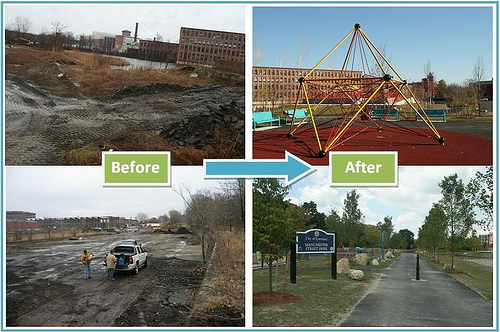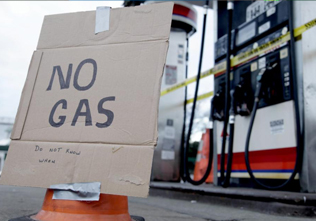Innovative local government leaders throughout the country are taking advantage of state and federal incentives to transform former landfills and contaminated industrial properties and waste sites into energy-producing wind and solar projects. Two examples of municipalities giving such contaminated properties new life are discussed in this article – redeveloping once polluted properties into solar installations in New Bedford, Massachusetts and revitalizing a former Bethlehem Steel plant into renewable energy projects in Lackawanna, New York.
Turning Environmental Liabilities into Environmental Assets
Brownfields are a challenge for municipalities. In many cases, these properties have been idle and under-utilized for decades due to the environmental stigma that has hindered their redevelopment for productive use. At first glance, these sites may not appear to be suitable candidates for siting commercial and utility-scale renewable energy facilities. But many of these properties have development potential that finally can be realized, thanks to a favorable regulatory and financial environment.
Many state and federal programs, such as the Environmental Protection Agency’s “Re-Powering America’s Land Initiative,” are spurring redevelopment through streamlined regulatory approvals, expedited permitting, reduced land acquisition costs, and financing and tax incentives. In fact, according to EPA, as of 2014, more than 135 renewable energy projects have been installed on 128 contaminated properties with a total capacity of more than 773 megawatts (MW).
The location of these properties in urban and industrial neighborhoods also plays a vital role in their redevelopment. Brownfields, including former industrial sites and municipal and hazardous waste landfills, are frequently located close to crucial infrastructure, such as electric transmission lines and substations, roads and water supply. Often, they comprise large land areas suitable for renewable energy development, and they already may be zoned and permitted to accommodate such redevelopment.
In addition to financial incentives, EPA offers liability protection to those who meet requirements under federal statutes like the Comprehensive Environmental Response, Compensation and Liability Act and the Resource Conservation and Recovery Act. Many states offer similar programs. Protections of this nature can help overcome environmental stigma that may attach to contaminated properties and prevent their redevelopment for productive use.
New Bedford’s Whale of a Transformation
In the past several years, New Bedford, Massachusetts, once America’s whaling capital, has tapped both state and federal incentives to reinvent itself as a major generator of solar power. New Bedford is just one of several Massachusetts communities developing renewable energy projects on contaminated lands in partnership with local utilities, private investors, and solar energy companies. The state’s Solar Renewable Energy Credit program has certainly helped, requiring utilities to buy electricity from solar installations, and providing specific incentives for renewable energy on landfills and brownfields.
The coastal southeastern Massachusetts city now has more than 16 MW of solar capacity installed or under construction, and is ranked second only to Honolulu, Hawaii for the most solar installed per capita. The city obtains 50 percent of its energy from solar, and is on track to buy two-thirds of all its energy from solar projects.
Several of the solar installations are on once-polluted properties, including a 500 kilowatt facility on a two-acre revitalized brownfield site at New Bedford High School. The city’s latest effort – a 1.8 MW installation on a 10-acre former toxic waste site – opened last fall and is expected to save the city $2.7 million in energy costs over its 20-year projected lifetime. The city still has one remaining project under construction – a 3.7 MW system in the New Bedford Business Park.
Since taking office in 2012, Mayor Jon Mitchell has spearheaded the city’s green strategy. The city’s solar projects are aimed not only at cutting local government’s utility bills and saving taxpayer dollars, but are part of a comprehensive environmental program to both clean up contaminated properties and reduce fossil fuel consumption. When complete, the combined solar energy projects will save the city government millions of dollars over the next 20 years through the availability of less expensive means of energy.
Former Bethlehem Steel Plant Gets New Life
Last fall in Lackawanna, New York, the City Council approved the installation of 13,000 solar panels on a portion of a former Bethlehem Steel plant site. When the steel mill shut down in the 1980s, the badly polluted 1,600-acre property sat dormant for two decades, before returning to productive use under the New York Department of Environmental Conservation’s Brownfield Cleanup Program. Now, the facility, which is operated by Apex Energy, will be one of the largest solar photovoltaic (PV) installations in New York State upon completion.
And, it will be the neighbor of one of the largest urban wind energy projects in the world – a 30-acre site also reclaimed from the sprawling, contaminated steel mill site. The two-phase Steel Winds project operated by Sun Energy and Apex Energy boasts 14 wind turbines with a capacity of 35 MW – enough clean electricity to power about 9,000 homes. The project has added hundreds of thousands of dollars in annual tax revenue to surrounding communities and school districts.
Risk Factors Must be Addressed
While brownfields may provide property owners and renewable energy developers with significant opportunities, such investments also carry risks. Therefore, project risk assessments and mitigation strategies must be addressed.
As with many other real estate opportunities, success depends on location, location, location. It is essential to identify the right brownfields property. Site studies are needed to determine the required level and cost of remediation to satisfy the environmental regulators, as well as the appropriate conditions for redevelopment, such as proximity to infrastructure, and the amount of available acreage on which to place the energy generation facilities. For example, solar projects often require more than 20 acres to be financially viable.
Another risk factor is liability. Risks must be addressed and managed. EPA and state environmental authorities have developed incentive programs with a variety of discretionary enforcement policies and property-specific documents to encourage site cleanups and facilitate contaminated property transactions and revitalization. Also, it may be more prudent to choose a property where remediation has been completed and the owner has received a “no further action letter” from the state regulatory agency. Further, the liability risk can be managed or mitigated, for example, through indemnity clauses in purchase and sale agreements or leases that allocate liability to the owner or responsible parties, as well as through environmental insurance policies to cover future unknown risks.
Before proceeding with a renewable energy project, it is important to determine whether a site is or may be subject to institutional or engineering controls that require approvals from appropriate regulatory agencies. And, a renewable energy project likely will need financing. Many traditional banks and equity providers may be reluctant to finance a project on a brownfield property. It is critical to identify financing partners who both understand the liability protections available to project lenders, and who are willing to support such projects.
If undertaken with the right combination of due diligence, creativity, incentives, and liability protections, the redevelopment of a brownfield into a renewable energy facility can provide a significant win-win proposition for many local communities.
Jeffrey M. Karp, Jerome C. Muys Jr. and Van P. Hilderbrand Jr. are environmental law attorneys with Sullivan & Worcester. Email: jkarp@sandw.com; jmuys@sandw.com; vhilderbrand@sandw.com.
By Jeffrey M. Karp, Jerome C. Muys Jr., and Van P. Hilderbrand Jr.
Source CleanTechnica.com







